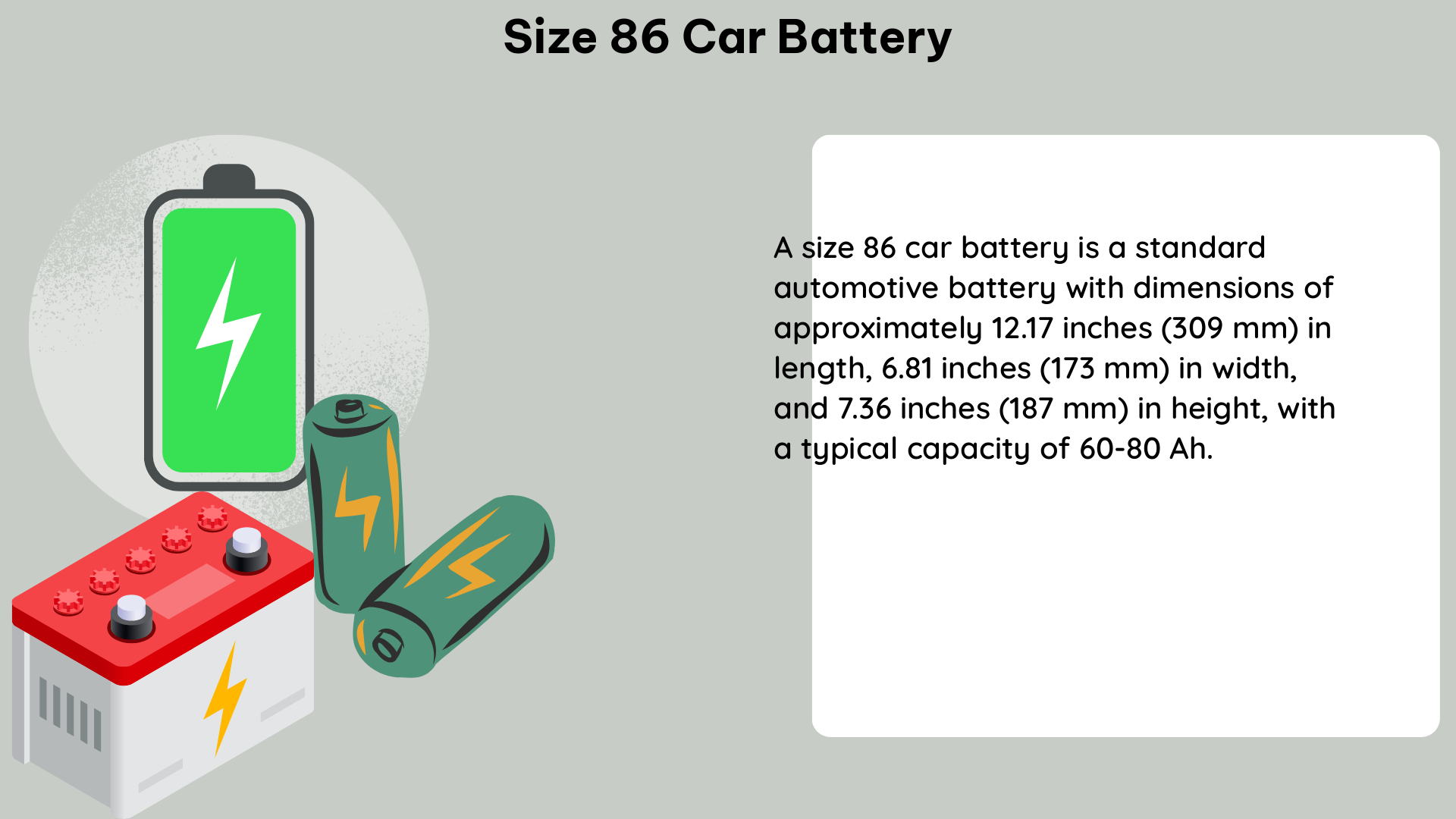The Group Size 86 car battery is a specific type of automotive battery that is designed to fit a wide range of vehicles. This battery is classified based on its voltage, overall dimensions, terminal arrangement, and other features that ensure proper fitment in the vehicle. In this comprehensive guide, we will delve into the technical specifications, measurable data, and DIY maintenance tips for the Size 86 car battery.
Technical Specifications of Size 86 Car Battery
Dimensions
The physical size of a Size 86 car battery must be within a tight tolerance of 2mm of other batteries in the same group size. This ensures that the battery fits snugly in the designated battery tray or compartment of the vehicle, providing a secure and reliable connection.
Performance
The performance of a Size 86 car battery is primarily measured by two key metrics:
- Cold Cranking Amps (CCA): This rating indicates the battery’s ability to start an engine in cold weather conditions. The CCA for a Size 86 car battery typically ranges from 600 to 850 amps.
- Amp-hours (Ah): This rating represents the battery’s total capacity, which is a measure of the amount of electrical charge the battery can store and deliver. The Ah rating for a Size 86 car battery typically falls between 55 to 75 Ah.
Terminal Arrangement
The terminal arrangement of a Size 86 car battery is designed to ensure that the vehicle’s electrical cables properly align and connect to the battery. This is an important consideration, as the terminal placement can affect the overall electrical system’s performance and reliability.
Chemistry
The standard Size 86 car battery uses a lead-acid chemistry with flooded technology. However, there are also higher-performance variants available, such as Enhanced Flooded Batteries (EFB) and Absorbed Glass Mat (AGM) batteries, which offer improved features like increased cycle life and enhanced cold-weather performance.
Measurable and Quantifiable Data for Size 86 Car Battery

Voltage
The voltage of a Size 86 car battery is typically 12 volts, which is the standard for most automotive electrical systems.
Cold Cranking Amps (CCA)
The CCA rating of a Size 86 car battery can vary depending on the manufacturer and model, but it typically ranges from 600 to 850 amps. This wide range allows for the selection of a battery that best suits the specific power demands of the vehicle.
Amp-hours (Ah)
Similar to the CCA rating, the Ah capacity of a Size 86 car battery also varies based on the manufacturer and model. The Ah rating for this battery type typically falls between 55 to 75 Ah.
Physical Size
The physical dimensions of a Size 86 car battery are typically 9.37 inches long, 5.16 inches wide, and 8.66 inches high. These measurements ensure a proper fit in the designated battery compartment of the vehicle.
DIY Maintenance Tips for Size 86 Car Battery
Proper maintenance is crucial for ensuring the longevity and optimal performance of your Size 86 car battery. Here are some DIY tips to keep your battery in top condition:
- Check Fluid Level: Regularly inspect the battery’s fluid level and top up with distilled water if necessary. This helps maintain the proper electrolyte concentration and prevents premature degradation.
- Clean Battery Terminals: Use a wire brush to remove any corrosion buildup on the battery terminals and cable ends. This ensures a clean and secure electrical connection.
- Use a Battery Charger: During periods of inactivity or extended storage, use a battery charger to maintain the battery’s charge and prevent it from becoming fully discharged.
- Replace the Battery: Depending on the manufacturer’s recommendations and the battery’s usage, replace the Size 86 car battery every 3 to 5 years to ensure reliable starting and performance.
By following these DIY maintenance tips, you can extend the lifespan of your Size 86 car battery and ensure that your vehicle’s electrical system continues to function at its best.
Conclusion
The Size 86 car battery is a crucial component of many vehicles, providing the necessary power to start the engine and support the electrical system. Understanding the technical specifications, measurable data, and proper maintenance procedures for this battery type is essential for ensuring reliable performance and prolonging its service life. Whether you’re a DIY enthusiast or a professional mechanic, this comprehensive guide has provided you with the information you need to effectively work with and maintain a Size 86 car battery.
References
- Battery Size Chart
- Battery Chemistry and Performance
- Group Size 75 vs. 75-86 Batteries
- BCI Group Sizes
- Difference Between 86s and 86 Car Battery

The lambdageeks.com Core SME Team is a group of experienced subject matter experts from diverse scientific and technical fields including Physics, Chemistry, Technology,Electronics & Electrical Engineering, Automotive, Mechanical Engineering. Our team collaborates to create high-quality, well-researched articles on a wide range of science and technology topics for the lambdageeks.com website.
All Our Senior SME are having more than 7 Years of experience in the respective fields . They are either Working Industry Professionals or assocaited With different Universities. Refer Our Authors Page to get to know About our Core SMEs.